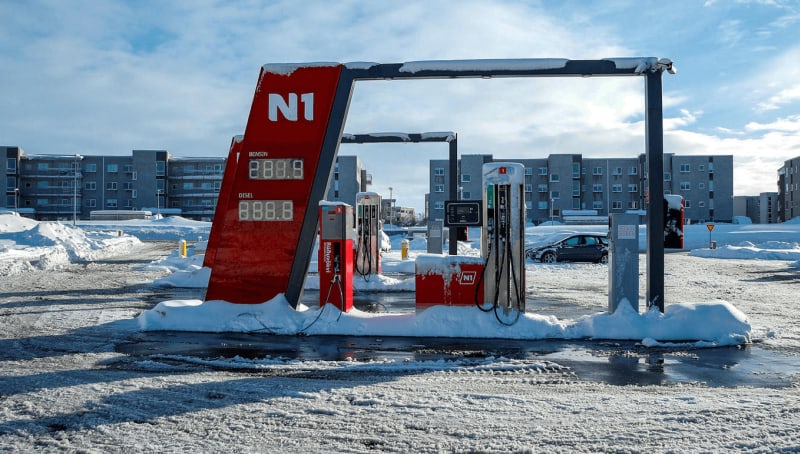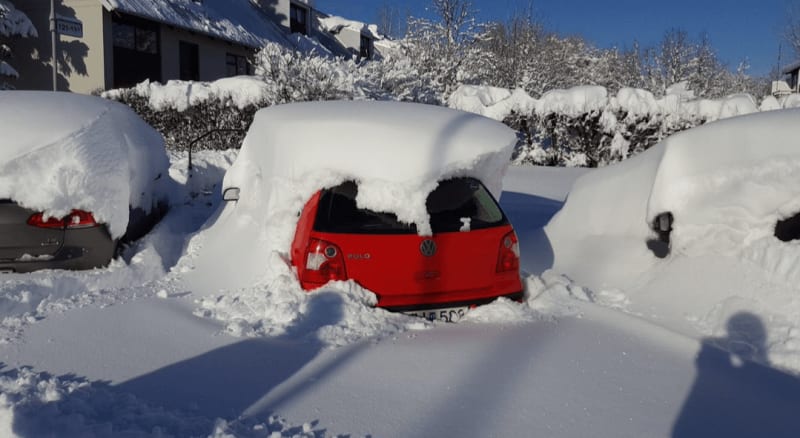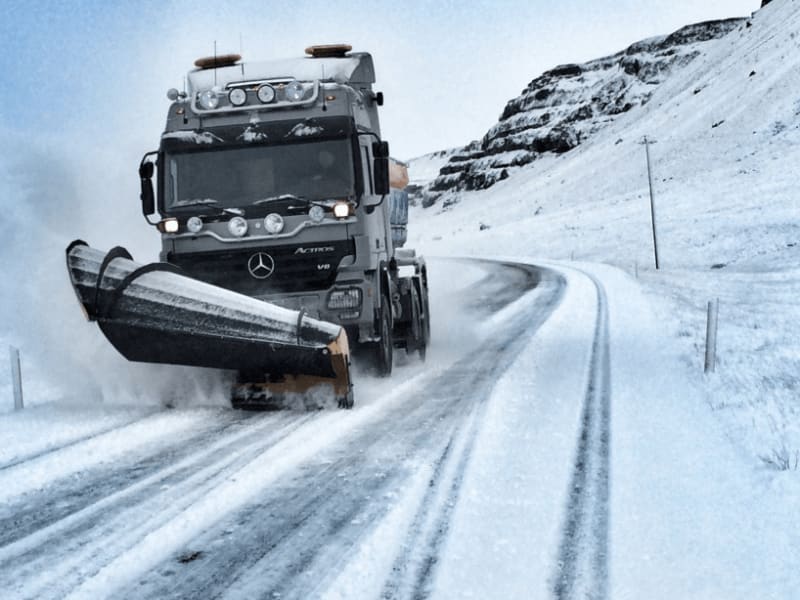Visiting Iceland in winter is now growing in popularity and we are seeing more and more vehicle bookings when it usually was very slow and considered as low season. Winter in Iceland means seeing the Northern Lights and experiencing total darkness with beautiful snowy scenery. This also means that more travelers will have to drive in harsh conditions, freezing weather with high strength snowy winds and icy roads.
Car Rentals in Iceland are always well prepared for winter by changing out the summer tires for studded winter tires as well as just doing more maintenance to keep their vehicles safe.
If you are not used to driving in snow or ice then this guide is perfect for you. This guide will serve facts and information about driving a rented vehicle in Iceland in winter time with studded tires and what to look out for as well as tips to safe driving on the icy roads during harsh weather conditions.
Tips for Driving in Winter in Iceland
Driving in winter in Iceland is no easy feat, it's quite demanding actually. Most that rent a car in Iceland are not aware that conditions can change from a sunny cold day to intense wind and snow with little to no visibility. Snow can be pushed by the wind over roads so you won't be able to follow witch direction you are going or visibly follow road signs. It's scary at times and you might have to just stop your vehicle and wait it out.
Here you will find some tips on safe driving in the harsh conditions of winter in Iceland.
Tip #1 - Listen to Warnings!
In Iceland we have weather these warnings:
Medium or high likelihood of medium impact weather which can have localized affects. This weather could affect travels between different areas of Iceland. The weather is potentially hazardous if precautions are not taken and can cause damages or accidents.
Medium or high likelihood of medium or high impact weather. This weather can will likely have short term impact on transportation, public services and infrastructure. This weather may cause damages or accidents. Can be a threat to lives if precautions are not take.
High likelihood of extreme weather causing high societal impact. Extreme weather with very hazardous conditions is forecasted. This weather can cause threat to life and property. High likelihood of nationwide disruptions to transportation, public services and infrastructure.
If you are new to driving in windy, snowy, icy conditions then you shouldn't be driving in any weather warning. If SaveTravel.is says "Do not Drive in this Weather" then you should not drive, it's just as simple as that. We have had many visitors stuck in heaps of snow and awful weather for a day or two, and it took a big toll on their health.
Now, of course the weather can change and sometimes there is just nothing you can do about it, that's not a rare occurrence in Iceland. We want your car rental experience to be the best while being as safe as possible.
Tip #2 - Check The Weather Conditions
Before you embark on your Iceland car rental winter adventure you will have to have a look at the weather forecast as well as check out SafeTravel.is where you can also subscribe to have weather warnings sent directly to your phone.
There are parts of Iceland that have worse weather (usually) and that is up North near Akureyri. Usually the wind blows harder and the snow fall is heavier during the winter months so before venturing north you will have to make sure that you have gathered weather information to be prepared for the worst.
Tip #3 - Bring Warm Clothing
Weather in Iceland can worsen instantly and leave you stranded. You might have to step outside the vehicle, shovel with your hands or take out the floor mats to put under the tires to make traction. We recommend having warm waterproof clothing that will keep you warm in any situation. Better to take clothes off than not having that extra layer.
Tip #4 - Full tank of Fuel
Always set out with a full tank of fuel, especially when you know you might hit harsh weather. What can happen is that you might get stranded on the side of the road and you want to keep warm by running the car. Well, if the fuel runs out things will get frosty, real quick.
Your first stop on your hired car should be a gas station before venturing further into the vast winter wonderland.

Tip #5 - Know when to Stop!
Sometimes it's just better to stop. If your visibility is non-existent, can't see the next car or even the road ahead of you, you should stop immediately. Don't take any unnecessary risks as you might cause an accident by driving head first into another vehicle or find yourself in a ditch with no way of getting out.
If stuck, call 112, the Icelandic Emergency number and/or your supplier.
Tip #6 - Slow and Steady wins the Race
The stronger the wind and harder the snow fall, you slow down. This should go without saying and really is undebatable because you might not only inflict harm to yourselves and passengers, but also to others on the road that are driving slow speeds.
There is no need to hurry in Iceland. Just keep calm, drive slow and stay on course.
Tip #7 - Prepare for a Night in the Vehicle
As previously stated you might need to stay over night if the weather keeps getting worse and you are not able to continue driving. Our recommendation is that you bring blankets, warm clothing, food, water and snacks. This could be a long night as Search & Rescue might not reach you until the morning after.
When in trouble, call 112, the Icelandic Emergency number and/or your supplier.
Tip #8 - Check the Tires
When renting a vehicle in Iceland it is mandatory for the supplier to have above average tires, they can't always be brand new as that would just not work, but the tires have to have good treads and also have to be studded in the winter time.
Make sure your tires are in good shape, the tire pressure looks right and during winter that they are studded. If they are not, ask the supplier to switch them out for new ones as you want to feel safe on the road.
Video on checking Tire Tread
Just a quick video on checking the tread on the tires as well as other damages to the tire.
Tip #9 - Black Ice / Clear Ice
Most accidents happen in Iceland when temperature reaches around 0° Celsius and this is the temperature where black ice, or clear ice, is most likely to occur. This kind of ice is a nearly transparent film of ice on a dark surface (such as a paved road or a body of water) that is difficult to see. Steering will become very unstable and accidents will occur at high speeds.
Soon as the dashboard states that temperatures are around 0° Celsius you will have to slow down and drive with extreme caution.
Tip #10 - No Cruise Control
It can be tempting while driving for a long period of time to use cruise control, especially if you are used to it. When the weather conditions are horrid and you will have to control your speed by slowing down or stopping then cruise control is not an option.
Basically, winter driving in Iceland will require you to be in full control at all times.
Tip #11 - Clear Snow and Ice Off your Vehicle
Make sure you scrape and clean all the windows before heading out. Driving in the winter requires full visibility and having ice and snow covering your car won't help. Police can also stop you and give you a fine if your windows haven't been cleared as you are a hazard for others.

Tip #12 - Distance Behind other Vehicles
Lengthen your following distance behind the vehicle ahead of you. Stopping distance on an icy road is double that of stopping on a dry one. For example, from around 45 metres (140 ft) at the speed of 60 km/h, to 80 metres (over 260 ft) on an icy road surface.
Tip #13 - What do to if you start to Skid ?
First of all, do not panic and push the breaks like your life depends on it. You will want to steer your vehicle in the desired direction and take your foot of the break AND the accelerator. If you break you will lock the tires and lose control of the rental car. Keep calm and
So...
- Stay Calm!
- Don't Push The Breaks
- Steer the vehicle in the correct direction
Tip #14 - Braking on a Slippery Road
When braking on a slippery road its important to understand and be aware of the situation. Below you will find a way to break on a slippery road with or without anti-lock brakes.
Breaking without anti-lock brakes
You can use the "Heel & Toe" method here, which means keeping your heel on the floor and tapping the breaks with your toes firmly, just short of locking the wheels.
Basically, you are just tapping the breaks until you have come to a full stop.
Breaking with anti-lock brakes
Same rule applies here with the heel & toe method but now you don't have to tap as much. The anti-lock braking system will do that for you, so you just press firmly on the breaks.
Tip #15 - Snow Plows

When they plow the road of snow they also lay salt on the road to melt the ice of the roads. This makes driving much safer and limits the risk of black ice.
Iceland Car Rentals and Winter Tires
All Iceland car rentals will have studded winter tires during the winter time but there are laws on when they are allowed to bet installed under the vehicle. The Icelandic Automobile Association makes sure that all cars rented in Iceland have studded tires due to the harsh conditions and to maximize the renters safety.
Bellow we will have a closer look at some facts about studded tires, as well as the laws and regulations and compare driving with studded and non-studded winter tires.

Winter time in Iceland is slippery, that's just a fact. Sometimes all-season tires or regular winter tires just don't cut it and then you will need to have studded winter tires installed. This just makes the harshest of conditions drive-able and ensures you have a safe ride.
Driving with studded tires does not mean that you can drive as fast as you like or that you can just drive like in the summer time. You still have to be careful. They do have the ability to grip the pavement through the ice or give you better traction on top of the ice. The treads on studded winter tires are unique as they as designed to grip snowy surfaces while the studs grip on ice.
Non-Studded Winter Tires
Non-studded winter tires, same as studded, have treads that enhance your grip on both slippery and dry surfaces. They are especially good for snowy surfaces and will enhance your grip in harsh conditions. The treads are more flexible and they assist the driver in having a smooth and safe ride.
Winter Tire Laws in Iceland
There are laws and regulations in Iceland regarding the date of installing studded tires. You can have regular winter tires on year round but due to airborne dust that occurs when driving with studs on dry pavement and it's impact on the environment, Iceland put law on date installed in place.
1st of November until the 14th of April is the time period as when the studded tires can be installed and have to be removed. If it starts to snow heavily before 15th of November you are allowed to put your studded tires on earlier than law states but you can only install them after The Icelandic Automobile Association and Law Enforcement has notified the public.
Car Rentals and Early Installed Studded Tires
Car Rentals might not accommodate you with installing studded tires early only due to your itinerary. Lets say it's not snowing in the capital but there is plenty of snow up North near Akureyri. If the law don't state you will have to install studded tire, your rental supplier might not do it until the 1st of November. We recommend contacting us before you arrive if you are unsure.
You might have to make changes if conditions aren't favoring your journey, type of car and tires underneath.
What to do in case of Emergencies
There are several factors to keep in mind if you find yourself in an emergency situation.
Here are some steps we recommend you take:
- Call 112, our main Emergency Number.
- If safe, stay inside your car.
- Contact your rental company and/or travel agency.
- Charge your devices while the car still runs.
- SafeTravel.is has an app that we recommend and you can notify through there.
- Keep the car running (watch the fuel) and keep the doors and windows closed.








 English
English Deutsch
Deutsch Français
Français Español
Español Italiano
Italiano Dansk
Dansk Polski
Polski Português
Português 日本語
日本語 Svensk
Svensk Nederlands
Nederlands Norsk
Norsk 中文
中文 한국어
한국어